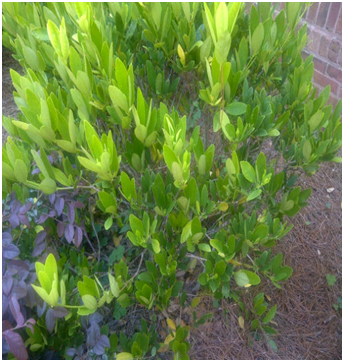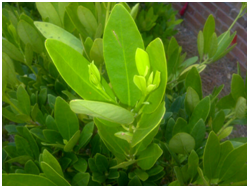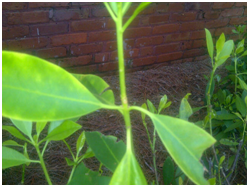Star Anise
Illicium parviflorum

(Photo by Ebony Armstrong)
View the Location on Campus
Taxonomy (2)
Classification: Angiosperm, dicot
Family: Illiciaceae
Common name: Yellow Anise, Yellow Anisetree, Star Anise
General Information (1,2)
Region of Origin: Florida
USDA Plants Hardiness Zones: 8-10
Growth Habit: Large shrub to small tree
- Size: 20 feet tall, 10-15 feet wide
- Deciduous/Evergreen: Evergreen
- Flowering: Spring and summer
Diagnostic Characteristics
Leaves (1,2)
- Arrangement: Alternate
- Simple/Compound: Simple
- Shape: Elliptical
- Other: Licorice odor when crushed

(Photo by Ebony Armstrong)
Stem/Bark (1,2)
- Color: Green
- Other: Fragrant

(Photo by Ebony Armstrong)
Flower (1,2)
- Color: Greenish-yellow
- Size: Less than 1 inch
(Photo by Jessica Bartek)
Fruit (1,2)
- Size: 0.5 to 1 inch
- Color: Green
(Photo by Jessica Bartek)
Horticultural Information (1,2)
- Light: Full shade to sun
- Soil type: Sand, loam, or clay
- pH: Acidic
- Maintenance: Low maintenance
- Landscape Uses: Shrub border, background shrub, hedge
- Other: Poor salt tolerance
Interesting Facts (1,2)
- Leaves smell like black licorice
- The term Illicium is Latin for allurement
- When dried, the leaves are used in potpourri
- The plant's leaves are toxic
References
1) Gilman, Edward F. (1999). Illicium parviflorum. University of Florida: Cooperative Extension Service. http://hort.ifas.ufl.edu/database/documents/pdf/shrub_fact_sheets/illpara.pdf
2) Scheper, Jack. (2003). Illicium parviflorum. Floridata. http://www.floridata.com/ref/i/illi_par.cfm
Edited by Jessica Bartek
Department of Biology
-
Room 2035, 2nd Floor
Bailey Science Building -
Mailing Address
1500 N. Patterson St.
Valdosta, GA 31698 - Phone: 229.333.5759
- Fax: 229.245.6585
Monday - Thursday
8:00AM until 5:30PM
Friday
8:00AM until 3:00PM
Saturday - Sunday
Office Closed